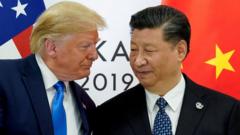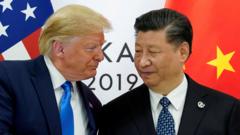In a significant move reflecting China's expanding military capabilities, the Chinese Navy has dispatched two aircraft carriers into the Pacific Ocean for joint exercises, observed by Japan’s defense minister, Gen Nakatani. This unprecedented operation marks a crucial advancement in China’s naval capacity to project its air and sea power from its coasts.
China Expands Naval Reach: Two Aircraft Carriers Conduct Pacific Exercises

China Expands Naval Reach: Two Aircraft Carriers Conduct Pacific Exercises
For the first time, China's aircraft carriers take to the Pacific, showcasing their capacity for extended military operations beyond home waters.
On June 10, 2025, Nakatani confirmed that the Chinese aircraft carriers, the Liaoning and the Shandong, were detected engaging in flight operations, including launching and retrieving fighter jets in the waters east of Iwo Jima, a strategic Japanese island located approximately 750 miles south of Tokyo. The Japanese Maritime Self-Defense Force has been actively monitoring this exercise, which commenced on Saturday and highlights a pivotal moment in the regional power dynamics.
With both carriers operating beyond Japan's First Island Chain, a natural barrier that Beijing aims to transcend, these maneuvers indicate a shift in the balance of power in the Western Pacific. China has been enhancing its naval capabilities, with a third aircraft carrier, the Fujian, already undergoing sea trials and a fourth currently under construction, allowing it to project greater military might over longer distances.
The significance of this operation lies in its potential to alter naval strategies in the region, particularly concerning U.S. forces, which would have to navigate near these waters to mobilize in defense of Japan or Taiwan during times of heightened tensions. While China's current carriers have fewer aircraft compared to the United States' fleet of 11 nuclear-powered carriers, the ongoing buildup has prompted Japan to develop its first small aircraft carriers since World War II, capable of accommodating U.S.-made F-35B stealth fighters.
With these developments, the stakes are rising in the Pacific theater, where the situation surrounding Taiwan remains a focal point, as China continues to assert its claims over the self-governing island and the United States vows to aid its defense.
Hisako Ueno contributed reporting from Tokyo. Martin Fackler is the acting Tokyo bureau chief for The Times.
With both carriers operating beyond Japan's First Island Chain, a natural barrier that Beijing aims to transcend, these maneuvers indicate a shift in the balance of power in the Western Pacific. China has been enhancing its naval capabilities, with a third aircraft carrier, the Fujian, already undergoing sea trials and a fourth currently under construction, allowing it to project greater military might over longer distances.
The significance of this operation lies in its potential to alter naval strategies in the region, particularly concerning U.S. forces, which would have to navigate near these waters to mobilize in defense of Japan or Taiwan during times of heightened tensions. While China's current carriers have fewer aircraft compared to the United States' fleet of 11 nuclear-powered carriers, the ongoing buildup has prompted Japan to develop its first small aircraft carriers since World War II, capable of accommodating U.S.-made F-35B stealth fighters.
With these developments, the stakes are rising in the Pacific theater, where the situation surrounding Taiwan remains a focal point, as China continues to assert its claims over the self-governing island and the United States vows to aid its defense.
Hisako Ueno contributed reporting from Tokyo. Martin Fackler is the acting Tokyo bureau chief for The Times.






















